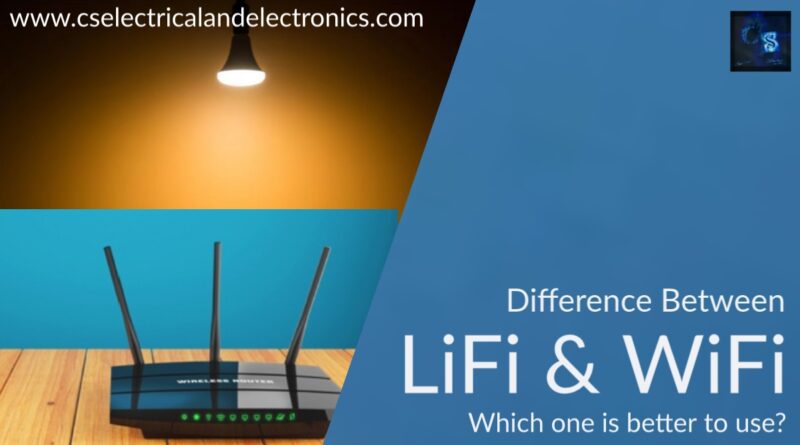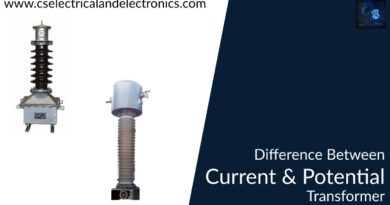Difference Between LiFi And WiFi, Which Is Best To Use
Hello guys, welcome back to my blog. In this article, I will discuss the difference between LiFi and WiFi, the latest technology which will replace WiFi with LiFi, and which will be best for you.
If you have any doubts related to electrical, electronics, and computer science, then ask questions. You can also catch me on Instagram – CS Electrical & Electronics And Chetan Shidling.
Also, read:
- Difference Between Hydrogen And Lithium, Future Of Electric Vehicle
- Top 10 Amazing Autonomous Vehicles Makers That Will Attract You
- Difference Between Virtual Reality And Augmented Reality
Difference Between LiFi And WiFi
Nowadays, we use WiFi in colleges, hospitals, and some other places to connect the internet to our phones or laptops. WiFi provides the internet through radio waves. Do you ever have imagined that the data can be transferred through light? Yes, the data can be transferred through the light by the LiFi system. The LiFi system transfers data through light such as LED bulbs. Below I will discuss the top 10 differences between WiFi and LiFi and I will also give the conclusion that which system is best to use.
01. Full-Form – The full of a LiFi is light fidelity whereas the full form of WiFi is wireless fidelity.
02. Operation – The LiFi transmits data using light with the help of LED bulbs whereas the WiFi transmits data using radio waves with the help of a WiFi router.
03. Interference – The LiFi system does not have any interference issues similar to radio-frequency waves whereas the WiFi system will have interference issues from nearby access points or routers.
04. Applications – The LiFi system can be used in airlines, undersea explorations, operation theaters in the hospitals, offices, and home premises for data transfer and internet browsing. The WiFi system is used for internet browsing with the help of wifi kiosks or wifi hotspots.
05. Merits – In LiFi, interference is less, can pass through salty seawater, works in the dense region. In WiFi, interference is more, can not pass through seawater, works in the less dense region.
06. Privacy – In LiFi, light is blocked by the walls and hence will give more secure data transfer. In WiFi, the RF signal can not be blocked by the walls and hence want to employ techniques to achieve secure data transfer.
07. Data Transfer Speed – The data transfer speed in LiFi is 1 Gbps. The data transfer speed in WiFi is WLAN-11n offers 150 Mbps, about 1-2 Gbps can be achieved using WiGig/Giga-IR.
08. Data Density – The LiFi system works in a high-density environment. The WiFi system works in a less dense environment due to interference-related issues.
09. Coverage distance – In the LiFi system, the coverage distance is up to 10 meters. In the WiFi system, the is about 32 meters (WLAN 802.11b/11g), which varies based on transmit power and antenna type.
10. System Components – In the LiFi system, the lamp driver, LED bulb (lamp), and photodetector will make up a complete LiFi system. In the WiFi system, requires routers to be installed, subscriber devices (laptops, PDAs, desktops) are referred to as stations.
Conclusion: According to my opinion the LiFi system is best to use in banks, hospitals, colleges, etc because the data will be secure and safe. But in theaters and dark rooms the WiFi system is the best thing to use.
These are the top 10 differences between LiFi and WiFi systems. I hope this article may help you all a lot. Thank you for reading.
Also, read:
- 100 (AI) Artificial Intelligence Applications In The Automotive Industry
- 6G Technology: What To Expect Beyond 5G
- Advancements In 3D Printing Technology And It’s Future
- Advancements In Power Electronics For Energy Efficiency
- AI Artificial Intelligence Applications In Electric Vehicles | Future?
- AI Tools For Electronic Circuit Design, Which Is Best?
- Applications Of Artificial Intelligence (AI) In Renewable Energy
- Autonomous Vehicle, Benefit, Drawback, Purpose Of Autonomous Vehicle
Author Profile
- Chetu
- Interest's ~ Engineering | Entrepreneurship | Politics | History | Travelling | Content Writing | Technology | Cooking
Latest entries
 All PostsApril 19, 2024What Is Vector CANoe Tool, Why It Is Used In The Automotive Industry
All PostsApril 19, 2024What Is Vector CANoe Tool, Why It Is Used In The Automotive Industry All PostsApril 13, 2024What Is TCM, Transmission Control Module, Working, Purpose,
All PostsApril 13, 2024What Is TCM, Transmission Control Module, Working, Purpose, All PostsApril 12, 2024Top 100 HiL hardware in loop Interview Questions With Answers For Engineers
All PostsApril 12, 2024Top 100 HiL hardware in loop Interview Questions With Answers For Engineers All PostsMarch 22, 2024Driver Monitoring Systems In Vehicles, Working, Driver Sleepy Alert
All PostsMarch 22, 2024Driver Monitoring Systems In Vehicles, Working, Driver Sleepy Alert








